Earlier this year, the Irish Government set an annual production target of 5.7TWh of biomethane by 2030, roughly 10% of the country’s current gas demand. It’s believed this would require over 200 new anaerobic digestion (AD) plants to be built.
Meanwhile, Irish agriculture has been set a challenging sectoral target of reducing greenhouse (GHG) emissions by 25% or 5.75Mt CO2 eq by 2030.
Bennamann, an English tech company based in Cornwall, believes it has a solution that will help contribute to both of these targets.
It has developed a farm-scale system to capture existing fugitive (escaping) methane emissions from slurry and convert them into a usable and valuable farm asset.
How the system works
The patented Bennamann solution works by covering new or existing outdoor slurry storage facilities and trapping the fugitive biomethane.
In theory, this is relatively easily done with outdoor lagoons and overground tanks, both of which make up the majority share of slurry storage systems in the UK compared to Ireland, where slatted tanks are more common. At the moment, the latter is not compatible, but the firm says it’s looking into ways in which a solution can be offered.
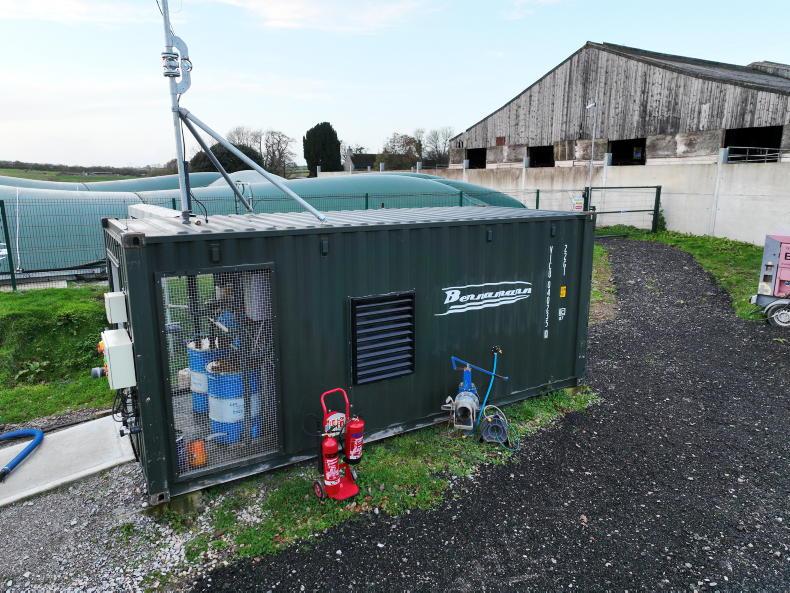
The gas filtration system is the first refinement step which removes hydrogen sulphide and partially dries the gas.
In recent years, outdoor slurry storage has increased in popularity in Ireland due to its cost-effectiveness. However, measures introduced as part of the Climate Action Plan state that as of 1 January 2022, all newly constructed outdoor stores are required to be covered.
In addition, it is expected that all existing outdoor stores will be required to be covered by 2024. Similar regulation is proposed in the UK.

The mobile processing unit or BioCycle arrives on site to clean the gas further removing water and Co2.
“Our system not only helps farmers become compliant in covering outdoor storage facilities but allows farmers an additional income from capturing the gas,” CTO and co-founder of Bennamann Dr Chris Mann explained.
Bennamann offers three options:
1 New build earth-bunded lagoon solution: The lagoon is lined with a 1mm thick plastic sheet, 0.7mm middle sheet and a 1mm thick UV-protected top cover. The ‘dirty’ gas is captured on top of the slurry before being removed, processed and stored as ‘clean’ gas in the separated top layer.
2 Retrofit concrete lagoon cover solution: A 1mm thick top cover is placed over the lagoon to capture the ‘dirty’ biogas. Once full, gas is processed and stored in a separate water-ballasted gas storage bag.
3 New build and retrofit steel/concrete overground store solution: Similar to option two, the store is fitted with the 1mm thick cover to capture the ‘dirty’ biogas. Once processed, ‘clean’ biogas is then stored in a separate water ballasted gas storage bag.
Slurry storage and gas capturing
The principle remains the same for each option. Slurry is fed from the shed into a reception tank and pumped through a macerator unit to one of four outlets around the perimeter/circumference of the store. Outlets are chosen in sequence so that the slurry never gets the opportunity to settle and crust.

The FPT hybrid generator has a methane powered engine has an output of 80kW.
Over time, slurry gases bubble to the surface where they are contained under the cover. Although raising the slurry temperature would increase anaerobic activity, Bennamann claims its aim is not to increase biogas production.
This happens naturally during the warm summer months as production stays relatively steady even though slurry volume has decreased from spreading in the spring.
Before spreading, slurry can be circulated through the macerator system, eliminating the need for an agitator. Another benefit claimed by Bennamann is that higher levels of ammonia are retained in the slurry.

CFM is stored at 250 bar meaning heavily reinforced cylinders are required which leaves 160kg of biomethane actually weighing 1,500kg.
Gas filtration system
Once there is a volume of ‘dirty’ biogas under the cover, the gas filtration process starts automatically. Hydrogen sulphide is removed and the gas is partially dried before storage in the top chamber of the lagoon cover or in the separate gas bag. In the event pressure builds too high, a flare burns off excess gas.
Gas upgrading/processing
Once the ‘clean’ gas store nears capacity, a portable BioCycle arrives on site to upgrade and clean gas further. Essentially, the water and carbon dioxide (CO2) is removed, increasing the purity of the biomethane from 65% to circa 93%.
The gas is then pressurised to 250 bar and transferred into cylinder packs for storage. At this stage the biogas is referred to as compressed fugitive methane (CFM) and is suitable for automotive use.
Each cylinder pack contains 160kg of CFM which according to Chris can refuel a New Holland T6.180 methane tractor five times.
The tractor has a working range of six to eight hours. Currently, CO2 is not utilised as part of the process but potentially will be in the future Chris said.
Pilot farms
Bennamann is operating a pilot project with Cornwall Council to prototype its franchise model which the firm hopes to roll out over the next 12 months. Here, six tenanted dairy farms milking between 100 and 300 cows have been fitted with the methane capturing system. Each farm has the capacity to store one week’s worth of gas which is processed on site using a mobile BioCycle.
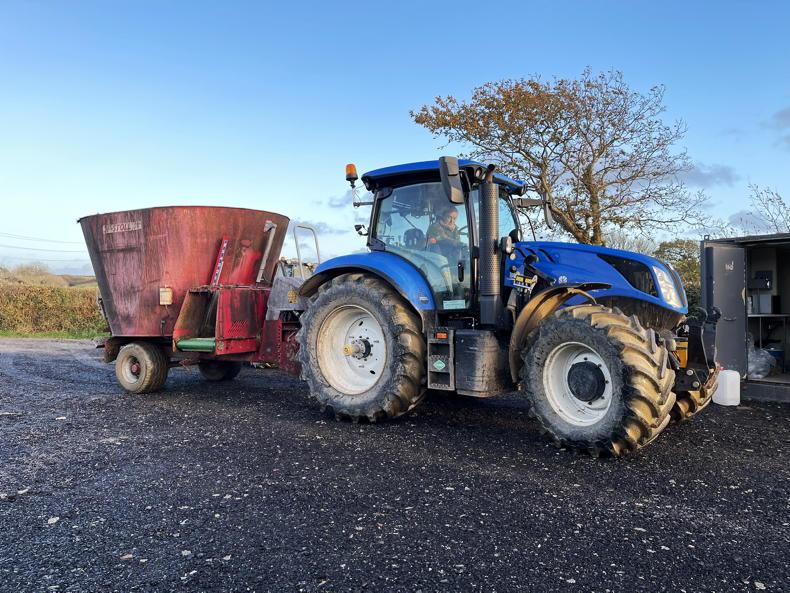
The New Holland T6.180 methane tractor working on one of the pilot farms.
Alongside powering a methane tractor and gas powered generators, excess gas is used by the council to run a fleet of 15 gas vehicles which are used for road maintenance.
According to Chris, 100kg of clean biomethane on average is captured daily on the farm we visited. This is from the slurry of 100 cows housed since October. Bennamann has remote access to each of the sites to monitor gas production.
The Bennamann model
Chris clearly outlined that the franchise model is where the company sees its future in order to remain affordable for the farmer. “Economically, farms will need to be in a cluster with one BioCylce processing unit serving six small- to medium-sized farms. The franchisee will look after everything from installations to remote site monitoring and, in turn, the operation and delivery of the BioCylce for gas processing as well as gas distribution.”

In overground storage systems or existing concrete walled lagoons 'clean' biogas is stored for further processing via the BioCylce.
Under the model, the farmer invests in the cover for the lagoon or tank as well as the ‘clean’ biogas storage bag, gas filtration system and flare. A profit sharing agreement is signed for Bennamann to carry out the processing, handling as well as sale and distribution of the
“Most dairy farms produce anywhere up to six times the fugitive methane than its energy requirement needs. The remaining gas is sold at a five-year fixed price and profits are shared with the farmer. They then have the opportunity to buy this clean biomethane for their own use at a reduced rate.”
Farmers in the pilot project are currently paying a reduced rate of £0.45/kg while a premium is charged to the transport sector at a price of £1.35/kg.
Biomethane generator
Bennamann has a vision that each farm should have the ability to become energy independent by means of a biomethane generator which would power the entire farm. FPT has developed a digitally controlled 80kW hybrid genset fitted with a 2.8l F28 four-cylinder engine and 37kWh battery.
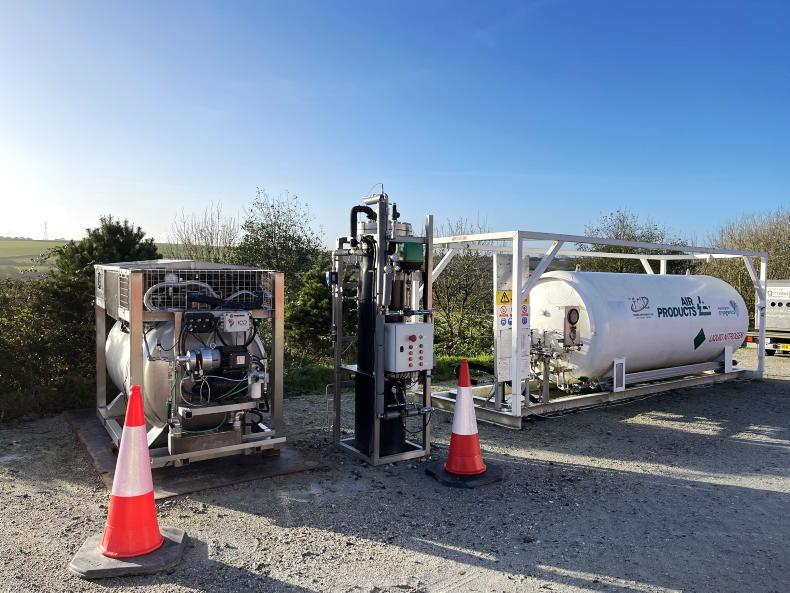
Depending on battery power output, the engine operates at a variable speed in order to be more efficient and charge the battery based on demand. The generator can produce both single- and three-phase power at varying voltages.
Although not commercially available, the price of this hybrid generator is expected to be between two and three times the price of a standard diesel generator.
Compressed gas v liquefied gas
At the moment what’s being harvested on each of the pilot farms is CFM, the majority of which is used to power vehicles such as the New Holland T6.180 methane tractor and the Iveco range of methane vehicles.
The main downside to CFM is its low energy density. Given the 250 bar pressure at which CFM is stored, heavily reinforced cylinders are required. In essence, 160kg (one day’s worth) of CFM has a transport weight of 1,500kg.
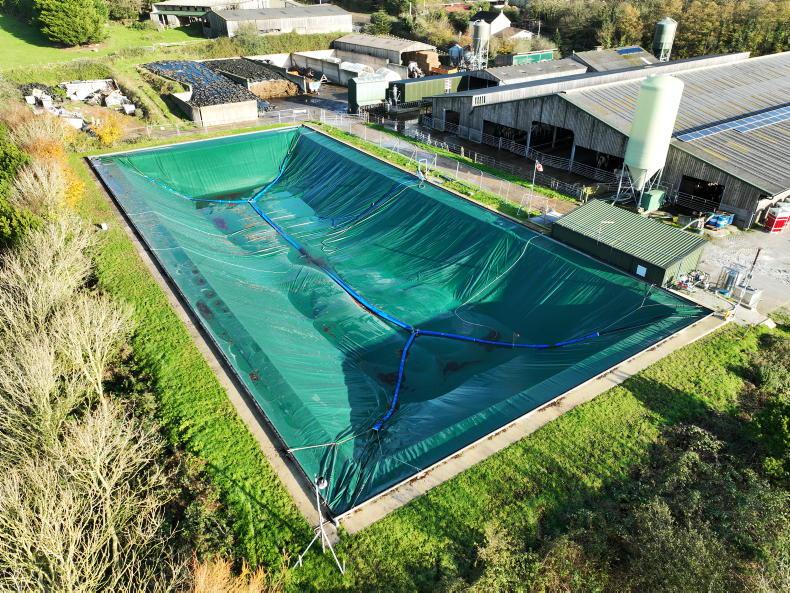
An empty lagoon.
Liquid fugitive methane (LFM) production is where the company sees the future from a logistics point of view and for the powering of heavy machinery.
LFM has roughly six times the energy density of CFM, mainly due to the fact it can be stored within a single cylinder or tank. Vehicles will be able to use a tank similar to a conventional tractor’s diesel tank.
According to Chris, the biggest risk with LFM in managing its temperature for which Bennamann has developed a purpose built tank for. It can independently maintain its temperature at -164°.
Who are Bennamann
Bennamann was established in 2011 by Dr Chris Mann and Michael Bennett - hence the name. Wanting to become involved in the renewable energy sector, the duo looked at a number of options.
Living in a large dairy area, the men quickly became aware of the challenges faced by farmers. This led to the birth of the methane capturing system.
Today, the company employs over 45 staff (and growing), based across two sites. In 2021, CNH acquired a 10% stake in Bennamann, a partnership which goes hand in hand with the CNH methane power strategy and especially the New Holland methane tractor.
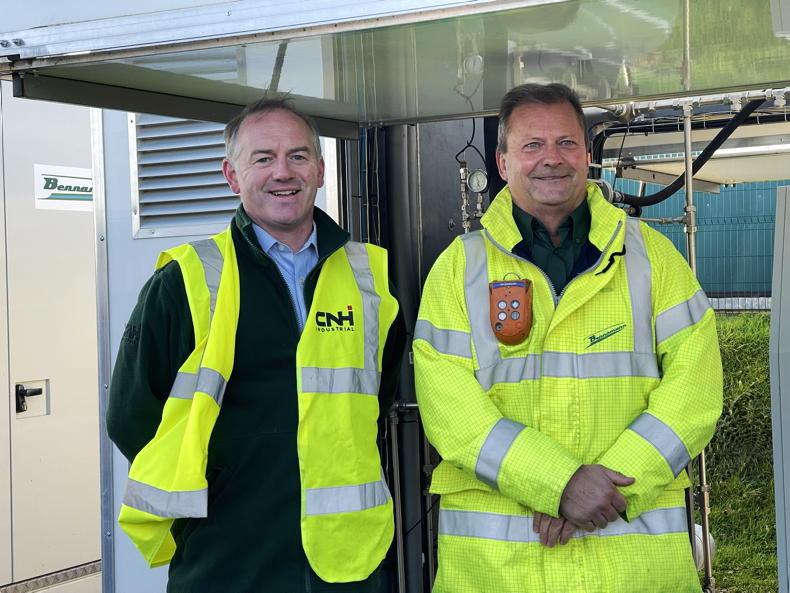
Seamus Gallagher and Chris Mann of Bennamann.
The company intends to establish Bennamann Ireland and Bennamann Northern Ireland in the coming 12 months with a further ambitious plan of having Ireland’s first pilot farm up and running by the end of the second quarter of 2023. From here, the aim is to establish franchises and get systems up and running.
While not a replacement for anaerobic digesters in terms of energy production, the Bennamann solution is without doubt a catchy concept from the point of view that it is an effective way of dealing with existing fugitive biogases at farm level. Not only does it reduce farm emissions, but it also helps with energy independence.
For the Irish market, a solution ideally needs to be derived that is compatible with slatted tanks. The regulation coming into effect in January and in the future on the covering of outdoor slurry storage facilities may encourage farmers to consider retrofitting the Bennamann system.
Alternatively, if grant aid was become available for the system (which the company hopes), more farmers may consider investing in overground storage and the biomethane capturing system.
The pilot farm project will be welcomed here in Ireland to see how viable the concept is from start to finish and answer many of the current unanswered questions.
Although farm storage situations vary, the company expects that a 100-cow dairy farmer should be able to have a system running for less than €130,000 plus VAT.
Bennamann believes a four-year return on investment is achievable on a system running a methane tractor and generator supplied by the slurry of 100 cows.
Earlier this year, the Irish Government set an annual production target of 5.7TWh of biomethane by 2030, roughly 10% of the country’s current gas demand. It’s believed this would require over 200 new anaerobic digestion (AD) plants to be built.
Meanwhile, Irish agriculture has been set a challenging sectoral target of reducing greenhouse (GHG) emissions by 25% or 5.75Mt CO2 eq by 2030.
Bennamann, an English tech company based in Cornwall, believes it has a solution that will help contribute to both of these targets.
It has developed a farm-scale system to capture existing fugitive (escaping) methane emissions from slurry and convert them into a usable and valuable farm asset.
How the system works
The patented Bennamann solution works by covering new or existing outdoor slurry storage facilities and trapping the fugitive biomethane.
In theory, this is relatively easily done with outdoor lagoons and overground tanks, both of which make up the majority share of slurry storage systems in the UK compared to Ireland, where slatted tanks are more common. At the moment, the latter is not compatible, but the firm says it’s looking into ways in which a solution can be offered.

The gas filtration system is the first refinement step which removes hydrogen sulphide and partially dries the gas.
In recent years, outdoor slurry storage has increased in popularity in Ireland due to its cost-effectiveness. However, measures introduced as part of the Climate Action Plan state that as of 1 January 2022, all newly constructed outdoor stores are required to be covered.
In addition, it is expected that all existing outdoor stores will be required to be covered by 2024. Similar regulation is proposed in the UK.

The mobile processing unit or BioCycle arrives on site to clean the gas further removing water and Co2.
“Our system not only helps farmers become compliant in covering outdoor storage facilities but allows farmers an additional income from capturing the gas,” CTO and co-founder of Bennamann Dr Chris Mann explained.
Bennamann offers three options:
1 New build earth-bunded lagoon solution: The lagoon is lined with a 1mm thick plastic sheet, 0.7mm middle sheet and a 1mm thick UV-protected top cover. The ‘dirty’ gas is captured on top of the slurry before being removed, processed and stored as ‘clean’ gas in the separated top layer.
2 Retrofit concrete lagoon cover solution: A 1mm thick top cover is placed over the lagoon to capture the ‘dirty’ biogas. Once full, gas is processed and stored in a separate water-ballasted gas storage bag.
3 New build and retrofit steel/concrete overground store solution: Similar to option two, the store is fitted with the 1mm thick cover to capture the ‘dirty’ biogas. Once processed, ‘clean’ biogas is then stored in a separate water ballasted gas storage bag.
Slurry storage and gas capturing
The principle remains the same for each option. Slurry is fed from the shed into a reception tank and pumped through a macerator unit to one of four outlets around the perimeter/circumference of the store. Outlets are chosen in sequence so that the slurry never gets the opportunity to settle and crust.

The FPT hybrid generator has a methane powered engine has an output of 80kW.
Over time, slurry gases bubble to the surface where they are contained under the cover. Although raising the slurry temperature would increase anaerobic activity, Bennamann claims its aim is not to increase biogas production.
This happens naturally during the warm summer months as production stays relatively steady even though slurry volume has decreased from spreading in the spring.
Before spreading, slurry can be circulated through the macerator system, eliminating the need for an agitator. Another benefit claimed by Bennamann is that higher levels of ammonia are retained in the slurry.

CFM is stored at 250 bar meaning heavily reinforced cylinders are required which leaves 160kg of biomethane actually weighing 1,500kg.
Gas filtration system
Once there is a volume of ‘dirty’ biogas under the cover, the gas filtration process starts automatically. Hydrogen sulphide is removed and the gas is partially dried before storage in the top chamber of the lagoon cover or in the separate gas bag. In the event pressure builds too high, a flare burns off excess gas.
Gas upgrading/processing
Once the ‘clean’ gas store nears capacity, a portable BioCycle arrives on site to upgrade and clean gas further. Essentially, the water and carbon dioxide (CO2) is removed, increasing the purity of the biomethane from 65% to circa 93%.
The gas is then pressurised to 250 bar and transferred into cylinder packs for storage. At this stage the biogas is referred to as compressed fugitive methane (CFM) and is suitable for automotive use.
Each cylinder pack contains 160kg of CFM which according to Chris can refuel a New Holland T6.180 methane tractor five times.
The tractor has a working range of six to eight hours. Currently, CO2 is not utilised as part of the process but potentially will be in the future Chris said.
Pilot farms
Bennamann is operating a pilot project with Cornwall Council to prototype its franchise model which the firm hopes to roll out over the next 12 months. Here, six tenanted dairy farms milking between 100 and 300 cows have been fitted with the methane capturing system. Each farm has the capacity to store one week’s worth of gas which is processed on site using a mobile BioCycle.

The New Holland T6.180 methane tractor working on one of the pilot farms.
Alongside powering a methane tractor and gas powered generators, excess gas is used by the council to run a fleet of 15 gas vehicles which are used for road maintenance.
According to Chris, 100kg of clean biomethane on average is captured daily on the farm we visited. This is from the slurry of 100 cows housed since October. Bennamann has remote access to each of the sites to monitor gas production.
The Bennamann model
Chris clearly outlined that the franchise model is where the company sees its future in order to remain affordable for the farmer. “Economically, farms will need to be in a cluster with one BioCylce processing unit serving six small- to medium-sized farms. The franchisee will look after everything from installations to remote site monitoring and, in turn, the operation and delivery of the BioCylce for gas processing as well as gas distribution.”

In overground storage systems or existing concrete walled lagoons 'clean' biogas is stored for further processing via the BioCylce.
Under the model, the farmer invests in the cover for the lagoon or tank as well as the ‘clean’ biogas storage bag, gas filtration system and flare. A profit sharing agreement is signed for Bennamann to carry out the processing, handling as well as sale and distribution of the
“Most dairy farms produce anywhere up to six times the fugitive methane than its energy requirement needs. The remaining gas is sold at a five-year fixed price and profits are shared with the farmer. They then have the opportunity to buy this clean biomethane for their own use at a reduced rate.”
Farmers in the pilot project are currently paying a reduced rate of £0.45/kg while a premium is charged to the transport sector at a price of £1.35/kg.
Biomethane generator
Bennamann has a vision that each farm should have the ability to become energy independent by means of a biomethane generator which would power the entire farm. FPT has developed a digitally controlled 80kW hybrid genset fitted with a 2.8l F28 four-cylinder engine and 37kWh battery.

Depending on battery power output, the engine operates at a variable speed in order to be more efficient and charge the battery based on demand. The generator can produce both single- and three-phase power at varying voltages.
Although not commercially available, the price of this hybrid generator is expected to be between two and three times the price of a standard diesel generator.
Compressed gas v liquefied gas
At the moment what’s being harvested on each of the pilot farms is CFM, the majority of which is used to power vehicles such as the New Holland T6.180 methane tractor and the Iveco range of methane vehicles.
The main downside to CFM is its low energy density. Given the 250 bar pressure at which CFM is stored, heavily reinforced cylinders are required. In essence, 160kg (one day’s worth) of CFM has a transport weight of 1,500kg.

An empty lagoon.
Liquid fugitive methane (LFM) production is where the company sees the future from a logistics point of view and for the powering of heavy machinery.
LFM has roughly six times the energy density of CFM, mainly due to the fact it can be stored within a single cylinder or tank. Vehicles will be able to use a tank similar to a conventional tractor’s diesel tank.
According to Chris, the biggest risk with LFM in managing its temperature for which Bennamann has developed a purpose built tank for. It can independently maintain its temperature at -164°.
Who are Bennamann
Bennamann was established in 2011 by Dr Chris Mann and Michael Bennett - hence the name. Wanting to become involved in the renewable energy sector, the duo looked at a number of options.
Living in a large dairy area, the men quickly became aware of the challenges faced by farmers. This led to the birth of the methane capturing system.
Today, the company employs over 45 staff (and growing), based across two sites. In 2021, CNH acquired a 10% stake in Bennamann, a partnership which goes hand in hand with the CNH methane power strategy and especially the New Holland methane tractor.

Seamus Gallagher and Chris Mann of Bennamann.
The company intends to establish Bennamann Ireland and Bennamann Northern Ireland in the coming 12 months with a further ambitious plan of having Ireland’s first pilot farm up and running by the end of the second quarter of 2023. From here, the aim is to establish franchises and get systems up and running.
While not a replacement for anaerobic digesters in terms of energy production, the Bennamann solution is without doubt a catchy concept from the point of view that it is an effective way of dealing with existing fugitive biogases at farm level. Not only does it reduce farm emissions, but it also helps with energy independence.
For the Irish market, a solution ideally needs to be derived that is compatible with slatted tanks. The regulation coming into effect in January and in the future on the covering of outdoor slurry storage facilities may encourage farmers to consider retrofitting the Bennamann system.
Alternatively, if grant aid was become available for the system (which the company hopes), more farmers may consider investing in overground storage and the biomethane capturing system.
The pilot farm project will be welcomed here in Ireland to see how viable the concept is from start to finish and answer many of the current unanswered questions.
Although farm storage situations vary, the company expects that a 100-cow dairy farmer should be able to have a system running for less than €130,000 plus VAT.
Bennamann believes a four-year return on investment is achievable on a system running a methane tractor and generator supplied by the slurry of 100 cows.














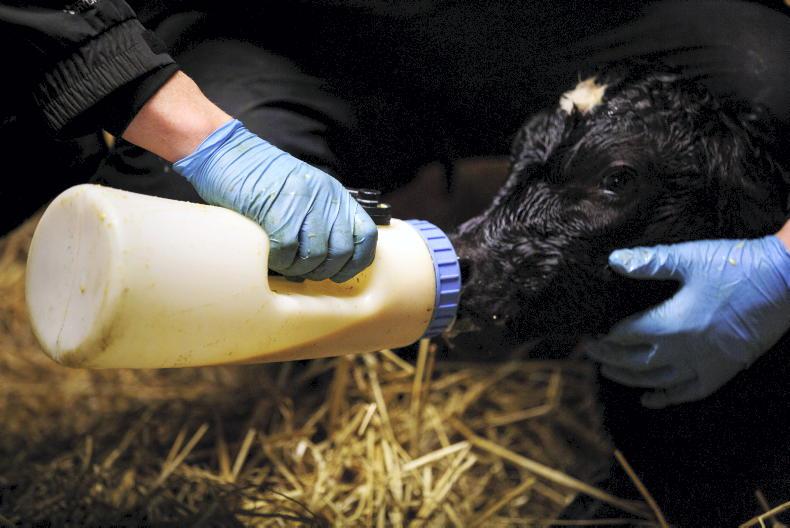

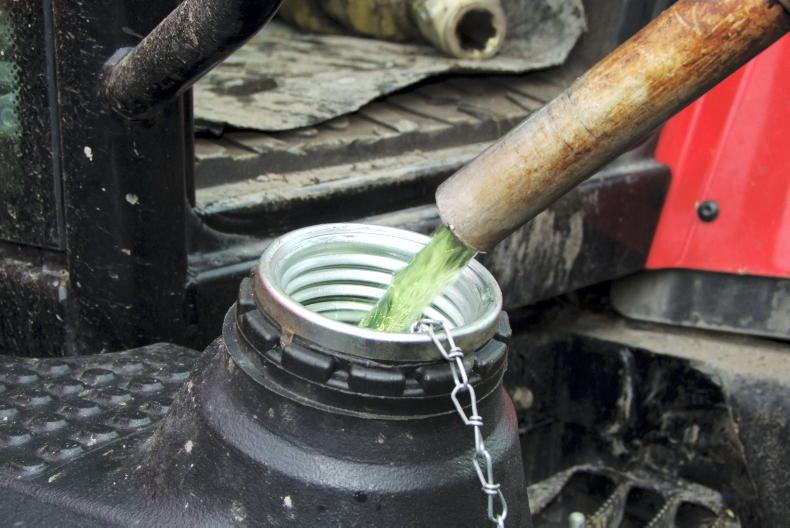
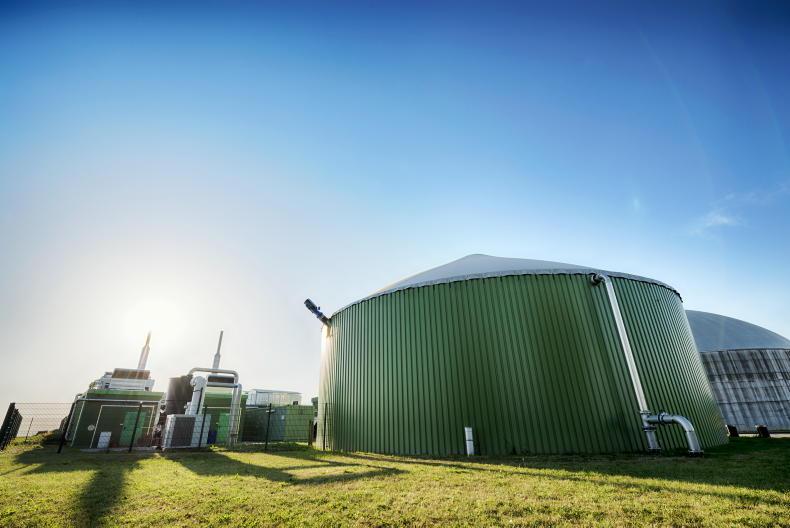
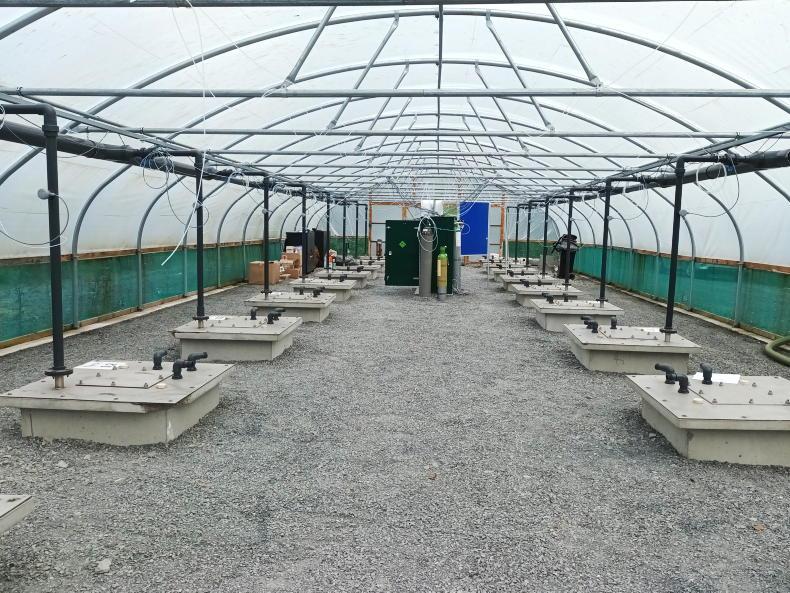
SHARING OPTIONS